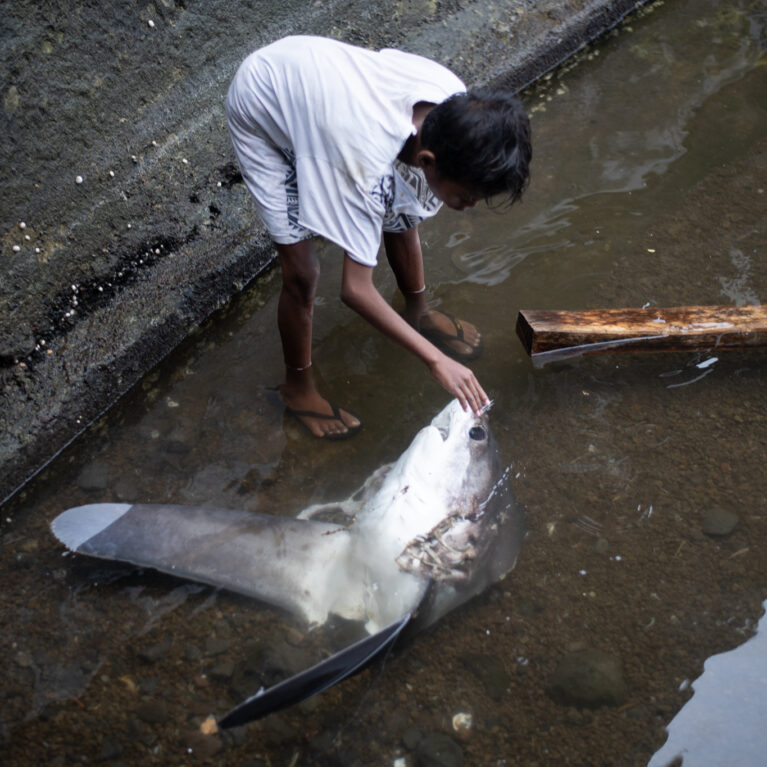The thresher sharks of Rhun Island
Indonesia’s Ay and Rhun Islands Marine Protected Area was declared in 2021, but three species of thresher shark were not listed as conservation targets. With no management plan that addresses the fisheries and no national or local policies to address thresher shark fisheries in particular, there is much left to do to manage the species’ populations. Rafid is collecting the first information about these fisheries with a view to developing the conservation and management strategies needed to effectively address thresher shark populations in the Ay and Rhun Islands Marine Protected Area.
An early-career conservationist from the city of South Tangerang, Indonesia, I was a Fellow at the University of Oxford‘s Interdisciplinary Centre for Conservation Science in Oxford, UK, and the winner of the Future Conservationist Award from the Conservation Leadership Programme. After graduating with a Bachelor’s degree, I moved to the coral triangle region of Indonesia, an epicentre of marine biodiversity. There my passion for sharks and rays was nurtured by voluntary work in Lamakera, East Nusa Tenggara, where the most manta rays in the world have been killed. I earned a Master’s degree from the
Uncover the Elusive Pelagic Threshers of Banda Neira in Indonesia
The objective of the project is to initiate the first effort to conserve the pelagic thresher shark in Banda Neira, Indonesia, by studying the fishery and the socio-economic dependence of the communities on it and by conducting public outreach programmes.
As populations of the pelagic thresher shark decrease across Indonesia, the species should become a priority for conservation. This project aims to provide comprehensive information about the status and utilisation of this Endangered species by exploring its population levels and socio-economic dependence on it. We focus on Rhun Island, the centre of fisheries activity in the Ay and Rhun Islands Marine Protected Area, in the heart of the coral triangle, where preserving marine biodiversity is critical.
Sharks are apex predators in the ocean, so it is essential to conserve and manage them if marine biodiversity is to be protected. Thresher sharks are most vulnerable to overexploitation by fisheries (as target and bycatch) because of their slow rate of reproduction. In the 2019 assessment of the IUCN Red List of Threatened Species, the pelagic thresher shark Alopias pelagicus was reclassified from globally Vulnerable to Endangered. The species is also listed on CITES Appendix II.
In 2021 a marine protected area was established around the islands of Ay and Rhun, but none of the three thresher shark species are listed as conservation targets in its management plan. There are also no fundamental national or local policies or measures to address the thresher shark fisheries, so the exploitation of pelagic thresher sharks remains unchecked. Moreover, the lack of reliable catch, effort and abundance information hinders stock assessment of the pelagic thresher shark at the local level.
The poor availability of data and the complexity of shark fisheries could lead to the implementation of conservation policies with limited understanding of the social dimension. The potential consequences for Rhun fishermen of reduced income from shark fisheries may be severe and could lead to the fishers resorting to catching sharks illegally. Understanding the motivation for shark fisheries can help to create policies that predict or adapt to these social consequences and promote compliance. Non-compliance is a primary challenge to halting declines in global shark populations.
The project will collect the first robust data and information about the local fisheries to develop future conservation and management of pelagic thresher sharks within Ay and Rhun Islands Marine Protected Area.
Summary of main research results/outcomes
Recent satellite tracking research in East Nusa Tenggara has traced the movements of pelagic thresher shark (Alopias pelagicus) between the Savu Sea and the Banda Sea, a significant fisheries area in eastern Indonesia. However, information about pelagic thresher sharks in the Banda Sea is scarce, increasing the risk to their population. This project provides preliminary insights into the pelagic thresher sharks and fisheries of the Banda Archipelago. Using a mixed social science approach, we conducted in-depth individual interviews and focus group discussions with 37 fishers across five islands. Our goal was to understand the livelihoods of local communities and their interactions with thresher sharks. The findings reveal that all interviewees primarily rely on fisheries for their livelihoods, with some having historically participated in shark fishing. Pelagic thresher sharks are found in 16 locations across the Banda Sea but are not targeted due to their low economic value.
Instead, they are at risk of bycatch in small-scale purse seine fisheries. Fishers report that thresher shark bycatch negatively impacts their operations, causing increased costs due to damaged nets. This highlights the potential effectiveness of implementing bycatch release interventions to solve this conservation challenge.
Public presentation at MODS: Save Our Seas Distinguished Speaker Series :Thresher Sharks of Rhun Island


